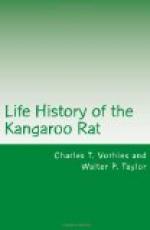Total species, exclusive of fungi, 41.
It will be seen from Table 3 that while a large number of species of plants are represented in the totals from so many dens, a majority of them are of very minor importance, and that the seeds of grasses are the principal storage and probably therefore the principal food material. Six of the most important species of grasses (disregarding species furnishing less than 5 grams) comprise 85.6 per cent of the total weight of storage from 22 dens. Crowfoot grama (Bouteloua rothrockii) stands first in quantity in the total, forming 39.4 per cent of all stored material, 46 per cent of the six important grasses, and 45 per cent of all grasses. The largest amount of storage of any one species of grass in any one den on the Range Reserve also is of this species, 2,205 grams[5] (Table 1, den 1, p. 20, and Pl. VII, Fig. 2). This is exceeded by a dropseed grass, Sporobolus cryptandrus strictus, which amounted to 5,455 grams in a lot from Albuquerque, N. Mex. (Table 1, den 24, and Pl. VIII, Fig. 1).
[Footnote 5: This amount
of dry grama grass seed (heads) amounts to
approximately a bushel.]
Of the species other than grasses found stored in these dens, mesquite beans (Prosopis velutina) are most important both by weight and number of dens containing them. The total for the 22 Range Reserve dens is 1,570 grams, or 35.9 per cent of the seeds other than grasses, but only 5.1 per cent of the total storage. In bulk mesquite beans do not loom up large, as they are probably the heaviest material stored. Sections of pods which must have been dragged into the burrows are found, some of them certainly being much too long for carriage in the pouches. The species of plant other than grass found in the largest quantity in any one den, however, was Aplopappus gracilis, not recorded in quantity from any den until the excavation of the twenty-second, and then found in a very large bulk of soft, fluffy material, with most of the seeds separated from the heads, and weighing 1,030 grams (Table 1, den 22).
Any of the food materials above listed are likely to be found in the cheek pouches, while in addition such extraneous matter as stones and feces have also been found. All species of plants stored are accessible in the immediate vicinity of the mound, and when any particular plant is found seeding in abundance in the vicinity of the den it is likely to be represented in the storage. Usually the animals can be readily trapped with almost any kind of grain bait, as oats, rolled oats, rolled barley, and wheat; and nut meats also are attractive, though we have no record of the storing of any true nut in the dens, such not being available in the range of the animal on the Range Reserve.
The following plants not represented in the list stored by the kangaroo rat on the Range Reserve have been found in the cheek pouches or mounds of spectabilis in other localities:




